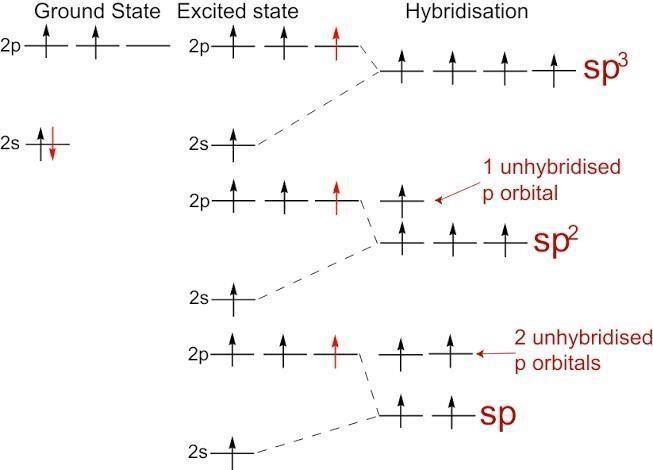
In
A.
B.
C.
D.None of these
Answer
496.8k+ views
Hint: Hybridisation is defined as a combination of atomic orbitals to form a new set of equivalent orbitals which are known as hybrid orbitals. When 3 of the p orbitals combine and one s orbital combines it forms sp3 hybridisation. When two p orbitals and one s orbital combines it forms sp2 orbital. When one p and one s orbital combine it forms sp orbital .

Complete step by step answer:
None of these :- as the first option is accurately correct so this option can’t be taken into consideration.
So, the correct answer is Option A.
Note:
Features of hybridisation:-
1.The number of hybrid orbitals is equal to the number of atomic orbitals that get hybridised.
2.The hybridised orbitals are always equivalent in energy and shape
3.The hybrid orbitals are more effective in forming stable bonds than in pure atomic orbitals.
4.Type of hybridisation indicates the geometry of molecule
Conditions for hybridisation:-
1.The orbitals present in the valence shell of the atom are hybridised.
2.The orbitals taking part in hybridisation must have only a small difference of energies.
3.Promotion of electron is not essential condition prior to hybridisation
4.It is not necessary that only half filled orbitals participate in hybridisation.

Complete step by step answer:
None of these :- as the first option is accurately correct so this option can’t be taken into consideration.
So, the correct answer is Option A.
Note:
Features of hybridisation:-
1.The number of hybrid orbitals is equal to the number of atomic orbitals that get hybridised.
2.The hybridised orbitals are always equivalent in energy and shape
3.The hybrid orbitals are more effective in forming stable bonds than in pure atomic orbitals.
4.Type of hybridisation indicates the geometry of molecule
Conditions for hybridisation:-
1.The orbitals present in the valence shell of the atom are hybridised.
2.The orbitals taking part in hybridisation must have only a small difference of energies.
3.Promotion of electron is not essential condition prior to hybridisation
4.It is not necessary that only half filled orbitals participate in hybridisation.
Recently Updated Pages
Master Class 9 General Knowledge: Engaging Questions & Answers for Success

Master Class 9 English: Engaging Questions & Answers for Success

Master Class 9 Science: Engaging Questions & Answers for Success

Master Class 9 Social Science: Engaging Questions & Answers for Success

Master Class 9 Maths: Engaging Questions & Answers for Success

Class 9 Question and Answer - Your Ultimate Solutions Guide

Trending doubts
State and prove Bernoullis theorem class 11 physics CBSE

What are Quantum numbers Explain the quantum number class 11 chemistry CBSE

Who built the Grand Trunk Road AChandragupta Maurya class 11 social science CBSE

1 ton equals to A 100 kg B 1000 kg C 10 kg D 10000 class 11 physics CBSE

State the laws of reflection of light

One Metric ton is equal to kg A 10000 B 1000 C 100 class 11 physics CBSE




